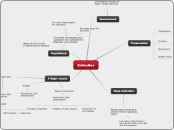Campus - Interaction Design
Context
Organisational
There will be a relationship towards displaying student ambassadors/presidents on the map interface through icons
The information that is displayed will be relevant towards the student in relation to the university environment
Certain features may need introduction/guidance when first using
Getting started tutorial/walkthrough
Tooltips/helpful messages to explain features
Time
Icons show/hide dependant on time of day?
E.g bars/events at night, cafes during day, study information during the day
Mostly daytime hours, during term time
Physical environments
Inside
Less space to manoeuvre, compact environment
Loud environments such as social areas will impact the feedback of sound
Outside
alternate routes the user can take to reach their desitnation
The main use of the application will be focused on the outdoors
Noise
Loud
(certain environments around campus, blocks/accomodations/bars).
Quiet
(certain environments around campus, library or study areas)
Semesters - autumn, winter + spring
Stressful at certain points of the year
Dry
Wet
Social environment will change on different conditions
Area could be 'home' for some students,
just treated as work for others
Technologies
Availability of network connection should be good, through wifi (eduroam most areas on campus). May be issues with drop in signal and the amount of mobile data required
Real time updates - Show user location through GPS, plus location of other people of interest (student reps or ambassadors)
Does not need to always be running in the background
Communication just between user and application, not with others.
Can show location of people of interest, such as student representatives or ambassadors
GPS Tracking
Web application instead of native app (Android, iOS, Windows etc.) Ensure is widely accessible
Screen size of mobiledevice may vary
Use of MediaQueries
Input
Text (keyboard input)
Speech
Gestures
Output
Information about surrounding/facility
Dependant on area
How to get there
Route types
Duration
Directions
Information about area
Attractions close by
Menu/Prices
Opening times
Imagery
Videos
Latest News or Events
RSS feed integration
Feedback
Text
Vibrations
Sound
Use of GUI, but not always neccessary for all users (thinking about different disabilities)
Activities
Error prevention
Input confirmation questions, "you have searched library", "would you like to go to the library?"
Messages will be displayed to highlight any user errors occured with easy workarounds to keep the focus.
A way in which errors can be prevented is through checking the destination that has been selected is what they asked for
Data input
A user can input information through both speech and text
Continuous flow, making the experience fluent for the user
Tasks
Tasks will be quick to complete, to avoid wasting time for the user to reach their destination
Helping the application to flow fluently through user interactions
Length of time of activity dependant on user location within campus
Users will most likely be regular users to begin with, and become less regular as they become more familar with campus and different areas the app helps with
User Goals
Get directions to certain areas of interest
Directions based on requirements/conditions. E.g route shown different for mobilitiy disability to someone without
Aim to make tasks easy to remember
Get information about certain areas of interest.
An app that is user friendly and caters to their needs
People
(Relevant user characteristics and skills)
All students studying
at a UWE campus
The use of the application will be expected to begin as a frequently used application, but as the user gets used to the surroundings, the application will become infrequent
Experience & Expectations
Users should expect to know their current location within the university campus within the app, as well as how to search for their destination.
The user doesn't necessarily need much experience with mobile applications. The interface and interactions should come naturally
Cognitive characteristics
Personality Characteristics
Perception
Learning abilities
Interface will allow easy to understand interactions. The more the application is used then the user will know their way around campus.
Memory
Memory will be served through geolocation of the users whereabouts, as well as an area for the users last entered locations.
Attention
Little amounts of attention will be required to use the application, however the user will need to be focused to ensure they get to the correct destination
May spend different amount of time
on campus for different reasons
Study from home
Part-time/full-time study
Live on campus or our outside
Multiple languages and
different cultures/backgrounds
Ages - typically 18-23
General assumption, good with technology
and experience with mobile applications
Particularly helpful for new students,
unfamilar with campus surroundings
and faciliities
Focused upon disabled users, but can be used by able users
Main Focus on people with various
disabilities
Athritis
Colour blindness
May have physical limitations
Mobility
Blind/Visual Impairment
Deaf
Physical Characteristics
Physical abilities
Motivation
People need to be motivated towards finding their destination, the interface should encourage them towards reaching their intended goal.









